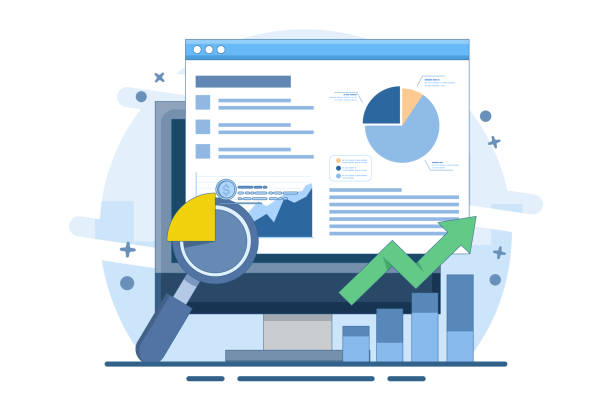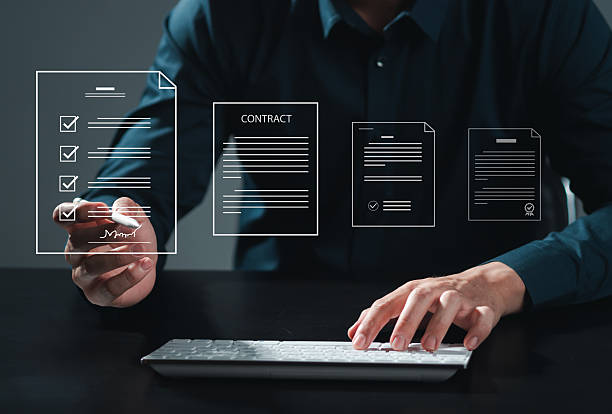In today’s digital world, having a website isn’t just about online presence; it’s about providing a memorable and user-friendly experience. Website design with a modern user interface goes beyond visual aesthetics, focusing on user experience (UX) and ease of use. This approach helps users easily interact with content and achieve their goals. A modern website with an advanced user interface not only attracts visitors but also converts them into loyal customers. The importance of this type of design stems from the fact that today’s users are looking for quick, visual, and pleasing solutions and no longer tolerate outdated and difficult websites.
Website design with a modern user interface means combining art and science to create spaces that are both beautiful and functional. This includes choosing colors, fonts, images, and layouts that are consistent with your brand while providing a clear and straightforward path for the user. Through user-friendly website design, businesses can build stronger relationships with their audiences, increase conversion rates, and strengthen their brand identity. In fact, this process is a strategic investment for the future of any business that wants to be a leader in the competitive digital space. This approach transforms the website into a powerful tool for interaction and sales, not just an online brochure.
Did you know that 94% of first impressions of a company relate to its website design?
Key Principles in Website Design with a Modern User Interface
In any website design with a modern user interface, adhering to specific principles is essential for achieving maximum efficiency and appeal. These principles include ease of use, visual aesthetics, and responsiveness, all revolving around the user and their needs. A website should be designed in such a way that the user can easily navigate and find the information they need without needing special training. Buttons and links should be clear and recognizable, and the user’s path should be logical and predictable.
Aesthetics are also a very important factor in the appeal of website design with a modern user interface. Using organized layouts, sufficient white space, a harmonious color palette, and appropriate typography helps create a pleasing visual experience. These visual elements not only make the website beautiful but also help in better understanding the content and guiding the user’s eye. Responsiveness means the ability of the website to display correctly on all devices with different screen sizes, from desktops to tablets and mobile phones. This principle ensures that users, regardless of the device they are using, achieve a consistent and satisfactory experience. These three principles form the foundation of any advanced and user-friendly website design and help your website stand out from the competition and increase user engagement. These are essential lessons for every web designer.
The Role of User Experience (UX) in Modern Design
User Experience (UX) refers to all aspects of a user’s interaction with a product or service and plays a central role in modern website design. UX goes beyond visual appearance, focusing on how the user feels when using the site, the ease of performing tasks, and their level of satisfaction. The UX process includes user research, creating personas, defining user journeys, information architecture, and wireframing. These steps help designers understand the needs, motivations, and behaviors of target users and, based on that, build a website that is truly useful and enjoyable for them.
A strong UX directly impacts the success of website design with a modern user interface. When a user can easily find what they need, quickly achieve their goals, and enjoy interacting with the site, the likelihood of them returning is higher, which means increased conversion rates and customer loyalty. UX is an iterative process that involves testing, collecting feedback, and continuous optimization. For example, A/B testing or usability testing helps identify the strengths and weaknesses of the design. This is a specialized discussion that requires a deep understanding of human behavior and digital interactions.
Tools and Modern Technologies in User Interface Design
For the successful implementation of website design with a modern user interface, using the right tools and technologies is essential. These tools allow designers to implement creative and functional designs quickly and with high accuracy. Some of the most commonly used user interface design software include Figma, Sketch, and Adobe XD. Each of these tools has its own special features; Figma is very popular due to its real-time team collaboration capabilities and web-based nature, Sketch is optimized for UI design in the Mac ecosystem, and Adobe XD is also noteworthy due to its integration with other Adobe products. The choice of the right tool depends on the needs and workflow of your design team.
In addition to design software, front-end technologies also play a vital role in implementing website design with a modern user interface. HTML5, CSS3, and JavaScript form the basis of any website. But to build interactive and complex user interfaces, JavaScript frameworks such as React, Vue.js, and Angular are widely used. These frameworks allow for faster development and better management of complex codes and allow designers to implement more advanced animations, effects, and interactions on the website. The right choice of these tools is a key guide to project success.
The Importance of Responsiveness and Mobile-First Design
In an era where users use a variety of devices to access the internet, responsiveness and the mobile-first approach have become cornerstones of website design with a modern user interface. Responsiveness ensures that your website automatically adjusts to the user’s screen size (whether desktop, tablet, or smartphone) and provides an optimal user experience on any device. This is not only important for user satisfaction but is also crucial in terms of SEO, as search engines like Google prioritize responsive websites in their rankings.
The mobile-first approach means that designers first design the mobile version of the website and then move on to larger versions. This way of thinking allows the design team to focus on essential content and functions, as screen space is more limited on mobile. This process often leads to designs that are simpler, more functional, and load faster. Given that the majority of internet traffic today comes through mobile devices, investing in a website design with a modern user interface that is mobile-first is an unavoidable necessity for any business seeking online success.
Psychology of Color and Typography in Modern Design
In any website design with a modern user interface, the psychology of color and typography are of paramount importance. Colors not only add beauty to the website but can also evoke specific emotions in users and influence their behavior. For example, the color blue usually evokes a sense of trust and calm, while red can convey excitement and urgency. The choice of a suitable color palette should be consistent with the brand identity and also compatible with the website’s purpose. Examining the impact of colors on user decision-making is a key part of this analysis.
Typography, or the art of choosing and arranging fonts, is equally important. Fonts play a significant role in the readability of content, visual hierarchy, and conveying brand personality. An inappropriate font can tire the reader and even cause them to leave the site, while appropriate fonts can improve the reading experience and convey the brand’s message more effectively. Font size, line height, and letter spacing all affect readability and overall aesthetics. A thorough analysis of these visual elements is essential for creating an effective and modern website design. By understanding how colors and fonts affect users’ minds, designers can create more powerful user experiences.
Security and Performance Alongside Beauty
Is a beautiful user interface enough for a modern website design? This is a question that many designers and developers must answer. While visual appeal and a pleasant user experience are vital, web security and website performance are equally important. A slow or insecure website, even if visually flawless, can frustrate users and damage brand reputation. Website loading speed directly affects bounce rate and SEO. Today’s users expect sites to load in a fraction of a second, otherwise, they will simply move on to your competitors.
On the other hand, website security is no longer a luxury but a necessity. With the increase in cyberattacks and concerns about data privacy, ensuring that your website is protected with an SSL certificate, user information is encrypted, and vulnerabilities are prevented is of paramount importance. An insecure website can destroy user trust and damage your business reputation. Therefore, website design with a modern user interface should include image optimization, caching, code compression, and the use of content delivery networks (CDNs) to increase speed. Also, adhering to best security practices and regularly updating systems and plugins are integral components of a comprehensive and successful design. This is thought-provoking content that shows that beauty without functionality and security lacks real value.
Challenges and Solutions in Website Design with a Modern User Interface
Despite the numerous advantages, website design with a modern user interface also comes with its own design challenges. One of the biggest of these challenges is balancing aesthetics and functionality. Sometimes, very beautiful designs may be complex or unpleasant in terms of usability. Another challenge is ensuring browser and device compatibility; what looks good in one browser may have problems in another. Managing content complexity and integrating new technologies are also common obstacles.
To overcome these challenges, there are proven modern solutions. Using A/B testing and continuously collecting user feedback helps identify usability problems. Modular design and the use of design systems can simplify the development process and prevent inconsistencies. Also, for website design with a modern user interface, an iterative approach should be adopted from the beginning, meaning that designs are continuously improved and adapted to user needs and new technologies. This comprehensive analysis shows that with careful planning and the use of appropriate tools, most challenges can be overcome.
Future Trends in User Interface Design
The world of website design with a modern user interface is constantly evolving, and new trends are emerging that further transform the user experience. Among these future trends is AI-powered personalization, which enables websites to customize content and layout based on each user’s individual behavior and preferences. This leads to much more relevant and engaging user experiences.
Other trends such as voice user interfaces (VUIs) are also gaining popularity, allowing users to interact with websites using voice commands. Augmented reality (AR) and virtual reality (VR) are also gradually finding their way into web experiences, providing the possibility of three-dimensional and immersive interactions. Micro-interactions, small and subtle animations that provide feedback to the user, are also becoming increasingly important for adding to the appeal and creating a more enjoyable user experience. These trends show that website design with a modern user interface is moving towards richer and more interactive visual experiences that communicate more intelligently with users. These exciting trends will make the future of the web more entertaining and advanced.
Conclusion and Importance of Investing in Modern Design
In conclusion, it is clear that website design with a modern user interface is more than just a design trend; it is a vital investment for any business in the digital age. A well-designed website that provides a seamless user experience not only strengthens brand image but also directly impacts conversion rates, customer loyalty, and ultimately, return on investment (ROI). In today’s competitive world, where users have countless options, a website with an outdated or difficult design can quickly lose visitors.
By focusing on the principles of user experience, responsiveness, aesthetics, and the implementation of modern technologies, businesses can ensure that their website not only meets the current needs of users but is also prepared for future trends. This approach means building a digital platform that is not only beautiful and efficient but is also constantly evolving and improving to maintain a superior user experience. The importance of website design with a modern user interface in ensuring competitiveness and sustainable growth in the online market is unparalleled. This concluding explanation highlights the main reason for the importance of this topic.




